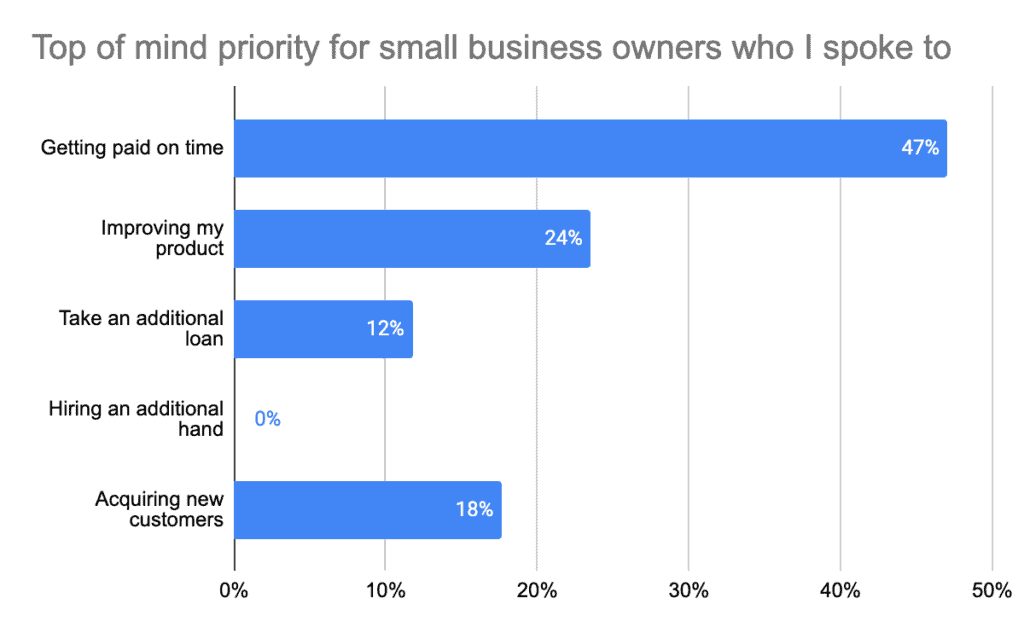A friend of mine who runs a successful event management company with more than 50 corporate clients told me that he is going to stop onboarding new clients as he is finding it extremely stressful to manage the additional work.
The additional work that comes with keeping customers happy, ideating and executing the new events to perfection and dealing with all the last minute and event-day escalations that come up all while keeping his existing clients happy and delivering on repeat business is a recipe for unlimited stress.
It’s undoubtedly stressful to do all of this, but hey, we business owners have signed up for this and more!
My friend’s reaction and his frustration got me thinking, is it better for a small business owner to maintain a business or should they look at growing them every year?
As a general rule, small businesses should grow revenues by at least 10% every year to continue operations and not be impacted by inflation. Only when business owners are faced with problems that need a permanent fix should they think about taking a temporary pause from growth.
I nudged my friend to focus the next couple of quarters on levelling up his team so that his immediate line managers can focus on some of the critical execution aspects. Delegation of responsibility and having a team member to delegate critical activities to is an important part of planning for any small business owner.
Once this is done, the focus for my friend should come back on trying to acquire new customers who will continue to keep his business engine going.
Small Business owners should have a laser focus on growth at all times
Like how CEOs of corporations focus on quarter on quarter performance, I urge small business owners to keep that as the key metric they focus on year over year. Though this is not something that we should obsess over, having an annual growth target would keep an underlying restlessness and call to action for the business and its employees.
For many small business owners, tracking month over month and year over year growth does not figure as the top of mind priority and they usually find out about their total revenue only when they do their taxes.
When I reached out to 17 different owners, only about 18% of them responded stating that acquiring new customers for the year was important for them. Only 24% of them said that acquiring new customers was their second priority.
47% of them said, their top of mind priority was to get paid or to collect payments on time.

While there can be periods of time, when the overall business environment is slow, the economy catches a cold and spending by people in general drops. These time periods can be when a business owner should focus on maintaining the business revenues stable rather than going in for growth.
An economic downturn is also the perfect opportunity to re-evaluate the costs that are incurred, cut down excess costs and adopt more frugal practices. The objective of doing this is to ensure that the business has sufficient cash balance to survive for the next 6-12 months if the economic conditions don’t improve.
When should a business owner evaluate if they should continue to grow the business or just maintain it?
When the business owner is faced with overwhelming growth or if too many things are breaking in the current business, it’s better to take a pause, to reflect and to fix things before going back to getting more customers.

I will share an example of another friend who runs a store selling herbal tea and other herbal products. Her store started well and she had good traction with customers walking in and and ended up doubling her revenues in less than 4 months. The products that did well were dried citrus fruit and flower based teas that were unique to her collection rather than the regular teas.
After a few months, she faced a problem of moulding due to moisture content in the teas that she sourced which caused more than two thirds of her inventory of specialty tea to go bad. This caused her business to take a hit for many months.
Her response to this was straightforward, she took off all the exotic varieties of tea from her store and stuck to the regular herbal teas with long shelf life. She spent this time working with her supplier on improving her packaging to ensure that all specialty tea blends were protected from moisture accumulation during shipping.
She then tested the new batches for mould to ensure that the packaging actually worked well and could last the recommended shelf life of the tea. It took her a good 8 months to get comfortable with the improvements she made.
At this point of time, her business declined a bit since there was no unique offering to drive growth. She added a few more products such as tea kettles and tea cups to diversify her offerings and stop the fall in revenues.

Once the specialty tea made a comeback, she planned and executed local promotions and gave away free samples during weekends and festival days. She also introduced newer flavours over time.
She doubled down on getting in more customers and in upselling to her regular customers once she was certain she could maintain her inventory at the desired quality.
Within 3 months of re-introducing the specialty teas, her business more than doubled and now a year later, she is steadily adding newer products and growing her revenues.
This is just an example of how a business owner focussed on finding a long term fix to the problem before pursuing growth. She consciously decided to slow down the business and maintain it at a level, fixed the basics and then once confident, planned and executed her growth strategy with great results.
Many business owners want their businesses to stay “small” to feel “comfortable”
This is a reaction I often get from some of my friends who run tutoring services, bespoke wedding services and such, that they like their “circle of friends” with whom they work and they feel they will lose the closeless and the “soul” of the business if they grow it.
I totally understand that you want your small business to still feel “small” and “friendly” and not like a soulless corporation. But even if you want to stay small, as a business owner, you will need to grow by at least 10% every year to just stay where you are.
If you do that, you will be “comfortably in the same space” over time than turn into a soul less company that many small business owners fear.
It’s simple, as much as we would like the world to remain the same; it continues to evolve, grow and change every day and the economic conditions that helped us set up the business and run-it will change over time as well and may work against us if we aren’t prepared.
A goal of growing our business by 10% every year, will constantly keep us in touch with the evolving needs of our customers by keeping us busy and not letting complacency set in. This growth is a small step we take every year which will allow for small adjustments in the way we work and not disrupt the culture we aspire to drive.
